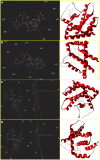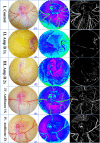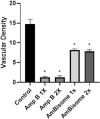Cytotoxicity of Amphotericin B and AmBisome: In Silico and In Vivo Evaluation Employing the Chick Embryo Model
- PMID: 35754489
- PMCID: PMC9214246
- DOI: 10.3389/fphar.2022.860598
Cytotoxicity of Amphotericin B and AmBisome: In Silico and In Vivo Evaluation Employing the Chick Embryo Model
Abstract
Leishmaniasis has been identified as a significant disease in tropical and subtropical regions of the world, with Iran being one of the disease-endemic areas. Various treatments have been applied for this disease, and amphotericin B (Amp B) is the second line of treatment. Side effects of this drug have been reported in various organs. The present study investigated the effects of different types of Amp B on fetal organs using in silico and in vivo assays (chicken embryos). In vivo analysis was done by checking pathological changes, angiogenesis, and apoptosis alterations on eggs treated by Amp B and AmBisome. In silico approach was employed to predict the affinity of Amp B and AmBisome to the vascular endothelial growth factor A (VEGF-A), its receptor (KDR1), apoptotic-regulator proteins (Bcl-2-associated X protein (Bax), B-cell lymphoma (Bcl-2), and Caspase-8. The ADME-toxicity prediction reveals that AmBisome possesses a superior pharmacological effect to Amp B. The best result of all the dockings in the Molegro Virtual Docker (MVD) was obtained between Bax, Bcl-2, Caspase-8, KDR1, and VEGF-A targets. Due to the lower Egap (HOMO-LUMO) of AmBisome, the chemical reactivity of AmBisome was higher than that of Amp B. In vivo analysis showed that embryos that received Amp B exhibited less vascular density than AmBisome. Amp B alone significantly increased the expression of apoptosis and decreased angiogenesis genes compared to AmBisome. The histopathology analysis of the treated embryos showed a reduction in the blood vessel collapse and an increase in degenerative and apoptotic-necrotic changes in the embryonic tissues. Overall, the results suggest the potential benefits of AmBisome over Amp B, which might be a better treatment strategy to treat leishmaniasis during pregnancy.
Keywords: amphotericin B; angiogenesis; apoptosis; chick embryo; in silico; in vivo; leishmaniasis; toxicity.
Copyright © 2022 Khosravi, Sharifi, Tavakkoli, Molaakbari, Bahraminegad, Salarkia, Seyedi, Keyhani, Salari, Sharifi, Bamorovat, Afgar and Dabiri.
Conflict of interest statement
The authors declare that the research was conducted in the absence of any commercial or financial relationships that could be construed as a potential conflict of interest.
Figures










Similar articles
-
Comparison of cytotoxicity of Miltefosine and its niosomal form on chick embryo model.Sci Rep. 2024 Jan 30;14(1):2482. doi: 10.1038/s41598-024-52620-4. Sci Rep. 2024. PMID: 38291076 Free PMC article.
-
Efficacy and safety of liposomal amphotericin B (AmBisome) for visceral leishmaniasis in endemic developing countries.Bull World Health Organ. 1998;76(1):25-32. Bull World Health Organ. 1998. PMID: 9615494 Free PMC article. Clinical Trial.
-
Post Kala-Azar dermal leishmaniasis following treatment with 20 mg/kg liposomal amphotericin B (Ambisome) for primary visceral leishmaniasis in Bihar, India.PLoS Negl Trop Dis. 2014 Jan 2;8(1):e2611. doi: 10.1371/journal.pntd.0002611. eCollection 2014. PLoS Negl Trop Dis. 2014. PMID: 24392171 Free PMC article.
-
Liposomal amphotericin B (AmBisome) for fungal infections in immunocompromised adults and children.Clin Microbiol Infect. 2001;7 Suppl 2:68-79. doi: 10.1111/j.1469-0691.2001.tb00012.x. Clin Microbiol Infect. 2001. PMID: 11525221 Review.
-
AmBisome: liposomal formulation, structure, mechanism of action and pre-clinical experience.J Antimicrob Chemother. 2002 Feb;49 Suppl 1:21-30. doi: 10.1093/jac/49.suppl_1.21. J Antimicrob Chemother. 2002. PMID: 11801577 Review.
Cited by
-
In silico and in vitro potentials of crocin and amphotericin B on Leishmania major: Multiple synergistic mechanisms of actions.PLoS One. 2023 Sep 8;18(9):e0291322. doi: 10.1371/journal.pone.0291322. eCollection 2023. PLoS One. 2023. PMID: 37682934 Free PMC article.
-
Empagliflozin induces apoptotic-signaling pathway in embryonic vasculature: In vivo and in silico approaches via chick's yolk sac membrane model.Front Pharmacol. 2022 Sep 1;13:970402. doi: 10.3389/fphar.2022.970402. eCollection 2022. Front Pharmacol. 2022. PMID: 36120349 Free PMC article.
-
An inclusive assessment of apoptosis mechanisms in Leishmania species: A narrative literature review.Curr Res Parasitol Vector Borne Dis. 2025 Apr 17;7:100260. doi: 10.1016/j.crpvbd.2025.100260. eCollection 2025. Curr Res Parasitol Vector Borne Dis. 2025. PMID: 40589914 Free PMC article. Review.
-
Exploring the antifungal potential of Cannabis sativa-derived stilbenoids and cannabinoids against novel targets through in silico protein interaction profiling.Front Chem. 2025 Jan 6;12:1515424. doi: 10.3389/fchem.2024.1515424. eCollection 2024. Front Chem. 2025. PMID: 39834844 Free PMC article.
-
The synergistic anti-leishmanial effect of photodynamic therapy employing chemotherapy-mediated nanocomposites.Sci Rep. 2025 May 10;15(1):16282. doi: 10.1038/s41598-025-01097-w. Sci Rep. 2025. PMID: 40348806 Free PMC article.
References
-
- Bahraminegad S., Pardakhty A., Sharifi I., Ranjbar M. (2021). The Assessment of Apoptosis, Toxicity Effects and Anti-leishmanial Study of Chitosan/CdO Core-Shell Nanoparticles, Eco-Friendly Synthesis and Evaluation. Arabian J. Chem. 14, 103085. 10.1016/j.arabjc.2021.103085 - DOI
-
- Bamorovat M., Sharifi I., Aflatoonian M. R., Sadeghi B., Shafiian A., Oliaee R. T., et al. (2019a). Host's Immune Response in Unresponsive and Responsive Patients with Anthroponotic Cutaneous Leishmaniasis Treated by Meglumine Antimoniate: A Case-Control Study of Th1 and Th2 Pathways. Int. Immunopharmacol. 69, 321–327. 10.1016/j.intimp.2019.02.008 - DOI - PubMed
-
- Bamorovat M., Sharifi I., Fekri A., Keyhani A., Aflatoonian M. R., Heshmatkhah A., et al. (2019b). A Single-Group Trial of End-Stage Patients with Anthroponotic Cutaneous Leishmaniasis: Levamisole in Combination with Glucantime in Field and Laboratory Models. Microb. Pathog. 128, 162–170. 10.1016/j.micpath.2018.12.040 - DOI - PubMed
LinkOut - more resources
Full Text Sources
Research Materials

